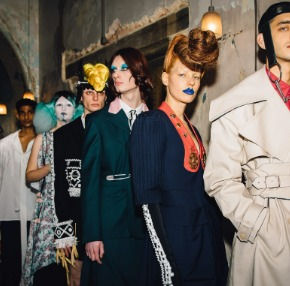Unholy Fashion: Making it Genderless
- Prava
- Mar 22, 2023
- 3 min read
A Step Towards Gender Equality

"A gender-equal society would be one where the word ‘gender’ does not exist, where everyone can be themselves.”
– Gloria Steinem
It was a few weeks ago that I realized that fashion is still confined by gender. Despite living in an age of gender fluidity, I was directed by the shop assistant to the woman's section. Why? Because obviously as a girl, I couldn't be seen wearing 'men's clothing'. How scandalous indeed!
Fashion is an art and like any other form of art, it is the expression of one’s truest self. Blair Waldorf said," Fashion is the most powerful art there is. It's movement, design, and architecture all in one. It shows the world who we are and who we'd like to be.”. Whether a person is considered to be “fashionable” or “stylish” or not the clothes that every individual wears say a lot about that person. Saying that a certain article of clothing has to be worn by a specific gender is definitely an antiquated social construct.
A piece of textile or fabric is considered to be genderless. However, as soon as it becomes a piece of the garment it assumes an audience it is meant to cater to. For example, a six-yard piece of material lying on the table can be utilised as anything but once that cloth has been fashioned into a saree it can only be worn by a woman.

Every time we walk into any fashion store we are forced to shop from either the men’s wear or women’s wear. The present-day system does not consider individuals who identify as non-binary. Individuals are pigeonholed by society's ideas of femininity and masculinity. The daintiness and grace of floral prints, pinks, and lace are fitting indeed for “women’s” clothing, and the assertiveness of solid, black, and graphic designs are perfect for “men’s” clothing.
Few offer a justification that this clear division of clothes into the binary genders is easier. It is easier than people can just enter the store and go to a section that is curated to their liking and that would save immense amounts of time.
In reality, this arrangement is not always productive. Say a man is looking to wear a pastel colour to wear on easter or just because his favourite colour is lilac he will not succeed in finding anything in his designated area. This is because society feels that light colours are “too feminine to be worn by a real man”. Undeniably, no man wants their masculinity to be questioned and hence he feels like he has to compromise on being himself in order to live up to societal standards.
Imagine if fashion was not based on gender identities, one could pick from a whole new array of things and wouldn’t feel compelled to meet external expectations. The fashion industry would greatly profit from this move as people would buy whatever they wanted and not what is expected of them. This would mean men would rush to department stores to buy skirts and dresses; women would eagerly buy more suits and trousers and sales will have skyrocketed. The question then arises, for whom is this system of segregation easier?
In fact, in the 14th century, men wore tights under their skirts almost every day. L’OFFICIEL USA’s website reported on 21st July 2022, “European royalty were donned in ornate skirts and heavy makeup and wore these “feminine” silhouette with pride. It wasn’t until 19th-century dandy fashion, pioneered by fashionable English aristocrats, reimagined masculine style through the emphasis of suits.”.

But things began to change with the turn of the century, celebrities like David Bowie in the 70s, Freddie Mercury in the 80s, and Kurt Cobain in the 90s began to embrace their so-called feminine sides and did not shy away from experimenting with different articles of clothing. Today, we see Harry Styles, Kid Cudi, Billy Portman, and many other famous personalities incorporate traditional women's wardrobes into their outfits.
For someone like me who identifies as a woman but still likes the baggy look of a “man’s” t-shirt shopping in the so-called men’s section is easier. But having said that, I also like wearing skirts and dresses, and this segregation of apparel into gender-specific divisions (based on unfashionable stereotypes) makes it ridiculous for these partitions even to exist.
Gender deconstruction is certainly not happening in the near future and it will take many years for it to actually happen but making fashion genderless is definitely one step closer to it.







Comments